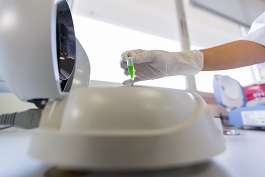Developed through the EU NANOART project, the new testing kit has already been applied to identify binders such as collagen and ovalbumin in ancient paint, not only in model samples painted in the lab but also in real samples collected from works of art.
'Once fully completed, our new tool will be made available to conservation scientists from around the world at an affordable cost (an assay can cost around EUR 0.5 per target), which will facilitate greater knowledge about historical works of art and help international museums, restoration art studios and laboratories to plan the best conservation and preventive strategies,' explains NANOART project coordinator Dr Jesus de la Fuente from the CSIC/University of Zaragoza, Spain.
In addition, the sensitiveness of the project's new nanotechnology-based methods means that smaller samples are required to be taken from the artwork for analysis. This in itself will help to better preserve our cultural heritage.
In order to characterise ancient paints, experts have often relied on conventional molecular biology methodologies that were developed decades ago. The concept behind the NANOART project was that these techniques could be substituted by more sensitive, inexpensive and faster techniques that take advantage of emerging nanotechnologies.
Furthermore, conventional methods – apart from being expensive – are also only available at a few laboratories, and require specialised personnel and equipment. A key objective of the NANOART project has been to address the cost issue by applying techniques developed for clinical diagnosis. In this way, the project is also highly original as it aims to take latest developments in clinical medicine and apply them to the conservation and preservation of cultural heritage.
'The innovative nature of the project is also denoted by the fact that there is currently no method or kit available that can be easily used at point-of-care to analyse paints without requiring expensive equipment and extensive training,' says Ana Claro, research fellow from the INA/University of Zaragoza. 'With the NANOART kit, the final user will be able to conduct an affordable analysis (in some cases at the cost of only a few euros) by simply following the instructions. Within a four-hour period, the results will be available.'
The potential opportunities opened up by the new analytical nanotechnology are huge. For example, developed in parallel with the NANOART kit, a spin-off company called NanoImmunotech has been launched in order to develop devices to detect bacterial infection in meat using the same technology as used in NANOART.
'This opens our technology to other applications far from cultural heritage applications,' says de la Fuente. 'However, we would like to continue further developing novel uses of NANOART technology for other applications in cultural heritage, and our next step will be to look for funding to develop an even more user friendly device.'
More information: For further information please visit the project coordinator website: www.unizar.es/EN
Provided by CORDIS
























